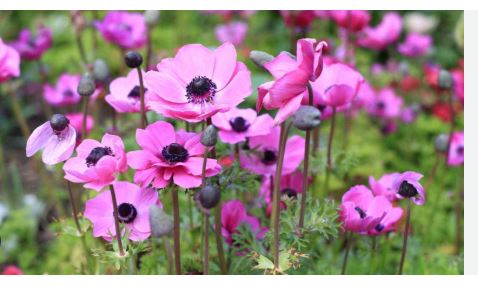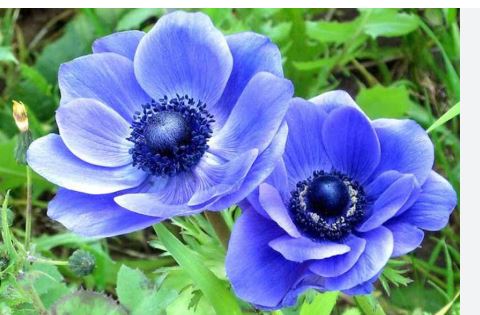
Anemone flowers, known as windflowers, are delicate and vibrant perennials in the Ranunculaceae family, cherished for their graceful blooms in U.S. gardens. Native to temperate regions worldwide, they display cup-shaped flowers in colors like white, pink, red, blue, and purple. Blooming from spring to fall, depending on the type, they enhance borders, woodlands, and arrangements with their airy elegance.
Originating in regions like the Mediterranean and Asia, anemones have been cultivated for centuries, valued by ancient cultures for ornamental and medicinal uses. Introduced to North America through European settlers, they’ve become popular for their adaptability and charm. In the U.S., they thrive in diverse climates, from California’s mild coasts to New York’s cooler zones, adding seasonal beauty.
Anemones feature star-like or poppy-like blooms with petal-like sepals surrounding a central disc, often with contrasting colors. Their foliage is typically ferny or lobed, forming low mounds or taller clumps, ranging from 3 inches to 4 feet. Grown from corms, tubers, or rhizomes, they spread gently, suiting various garden styles.
Anemones prefer well-drained, humus-rich soil with consistent moisture, thriving in full sun to partial shade. In the USA, they’re planted in fall or spring, blooming March to October, and are available as corms or plants at nurseries, especially in states like Oregon and Pennsylvania. They’re deer-resistant and attract pollinators, boosting garden vitality.
Anemones offer ecological and emotional benefits, supporting bees and butterflies. Their delicate blooms provide a calming, aesthetic uplift, enhancing well-being. Low-maintenance with proper care, they’re a sustainable choice for diverse, health-conscious U.S. gardens.

Anemone Flowers
Poppy Anemone (De Caen Group – White)
A tuberous Anemone coronaria cultivar with crisp white, single blooms resembling poppies. Its bright, open flowers with dark centers are a favorite for spring cut flowers and garden borders in warmer U.S. zones.
Identifying Characteristics:
- White, single blooms, 3-4 inches across, with black central disc.
- Six to eight silky sepals (petal-like), no true petals.
- Ferny, parsley-like foliage; stems 10-24 inches tall.
- Blooms spring (fall-planted) or late summer (spring-planted); Zones 7-10.
Poppy Anemone (De Caen Group – Scarlet)
A striking Anemone coronaria cultivar with vivid scarlet-red, single blooms and a bold black center. Its vibrant color makes it a standout in containers, cutting gardens, or mass plantings in mild climates.
Identifying Characteristics:
- Scarlet-red, single blooms, 3-4 inches across, with black center.
- Six to eight smooth sepals; poppy-like appearance.
- Finely divided, green foliage; stems 10-24 inches tall.
- Blooms spring or late summer; Zones 7-10, grown as annuals in cooler zones.
Poppy Anemone (St. Brigid Group – Double Red)
A double-flowered Anemone coronaria cultivar with rich red, ruffled blooms packed with extra sepals. Its lush, full flowers add drama to spring displays and are popular in floral arrangements.
Identifying Characteristics:
- Deep red, double blooms, 3-4 inches across, with layered sepals.
- Dark central disc; fuller, frilly appearance than single forms.
- Fern-like foliage; stems 10-12 inches tall.
- Blooms spring (fall-planted); Zones 7-10, annual in Zones 4-6.
Grecian Windflower (Blue Shades)
Anemone blanda cultivar with charming, daisy-like blooms in shades of blue to periwinkle. This low-growing, spreading plant is ideal for naturalizing under trees or in rock gardens, blooming early spring.
Identifying Characteristics:
- Blue to periwinkle, star-shaped blooms, 2-3 inches across, with yellow centers.
- 9-15 sepals; mat-forming, ferny foliage.
- Plant height of 3-6 inches, spreading 6-8 inches.
- Blooms early spring; Zones 4-8, prefers well-drained soil.
Grecian Windflower (White)
A delicate Anemone blanda cultivar with pure white, star-shaped blooms and golden centers. Its compact, spreading habit makes it perfect for woodland gardens or as a spring ground cover in cooler U.S. regions.
Identifying Characteristics:
- White, daisy-like blooms, 2-3 inches across, with yellow anthers.
- 9-15 sepals; deeply lobed, fern-like foliage.
- Plant height of 3-6 inches, spreading 6-8 inches.
- Blooms early spring; Zones 4-8, tolerates partial shade.
Japanese Anemone (White)
An Eriocapitella × hybrida (formerly Anemone × hybrida) cultivar with elegant, single white blooms on tall stems. This fall-blooming perennial adds grace to shade gardens and borders, attracting pollinators.
Identifying Characteristics:
- White, single blooms, 2-3 inches across, with yellow centers.
- Five to six sepals; fuzzy, dark green foliage.
- Plant height of 2-4 feet, spreading 2-3 feet.
- Blooms late summer to fall; Zones 4-8, prefers partial shade.
Japanese Anemone (Pink)
A robust Eriocapitella × hybrida cultivar with soft pink, cup-shaped blooms. Its long-lasting fall flowers and spreading habit make it a staple for cottage gardens or shady U.S. borders.
Identifying Characteristics:
- Pale to deep pink, single or semi-double blooms, 2-3 inches across.
- Yellow centers; lobed, dark green foliage.
- Plant height of 2-4 feet, spreading 2-3 feet.
- Blooms late summer to fall; Zones 4-8, may spread vigorously.
Wood Anemone (White)
Anemone nemorosa, a rhizomatous woodland native, produces delicate, star-shaped white blooms in early spring. Its low-growing, spreading habit is ideal for naturalizing in shady U.S. gardens.
Identifying Characteristics:
- White, single blooms, 1-2 inches across, with yellow anthers.
- Five to eight sepals; deeply lobed, basal foliage.
- Plant height of 6-12 inches, spreading 12-18 inches.
- Blooms early spring; Zones 4-8, thrives in humus-rich soil.
Meadow Anemone
Anemone canadensis, a North American native, features small, white blooms in clusters. This vigorous, spring-blooming perennial suits naturalized areas or moist borders in U.S. gardens.
Identifying Characteristics:
- White, single blooms, 1-2 inches across, with yellow centers.
- Five sepals; coarsely toothed, basal foliage.
- Plant height of 12-24 inches, spreading 12-18 inches.
- Blooms late spring to early summer; Zones 3-8, tolerates wet soil.
Snowdrop Anemone
Anemone sylvestris, a European native, produces fragrant, white, nodding blooms in spring, sometimes reblooming in fall. Its spreading habit suits woodland or cottage gardens in cooler U.S. zones.
Identifying Characteristics:
- White, single blooms, 1.5-3 inches across, with yellow centers.
- Five to six sepals; lobed, green foliage.
- Plant height of 12-18 inches, spreading 12-24 inches.
- Blooms late spring, may rebloom; Zones 4-8, prefers partial shade.
Grapeleaf Anemone
Anemone tomentosa, a tall perennial with silvery-pink to white blooms in late summer to fall. Its grape-like foliage and height make it a striking backdrop for U.S. borders or wildflower gardens.
Identifying Characteristics:
- Silvery-pink to white, single blooms, 2-3 inches across, with yellow centers.
- Five sepals; deeply lobed, grape-like foliage.
- Plant height of 2-4 feet, spreading 2-3 feet.
- Blooms late summer to fall; Zones 4-8, tolerates sun or shade.
Scarlet Windflower
Anemone multifida, a North American native, features vibrant scarlet-red blooms with contrasting black stamens. Its compact, spring-blooming habit suits rock gardens or borders in cooler U.S. climates.
Identifying Characteristics:
- Scarlet-red, single blooms, 1-2 inches across, with black stamens.
- Five to ten sepals; finely divided, ferny foliage.
- Plant height of 6-12 inches, spreading 6-12 inches.
- Blooms late spring to early summer; Zones 3-7, prefers well-drained soil.
Poppy Anemone (De Caen Group – Blue)
A vibrant Anemone coronaria cultivar with striking blue, single blooms and a dark central disc. Its poppy-like flowers are ideal for spring borders, containers, or cut flowers in warmer U.S. climates.
Identifying Characteristics:
- Bright blue, single blooms, 3-4 inches across, with black center.
- Six to eight silky sepals; poppy-like appearance.
- Ferny, parsley-like foliage; stems 10-24 inches tall.
- Blooms spring (fall-planted) or late summer (spring-planted); Zones 7-10.
Poppy Anemone (St. Brigid Group – Double White)
A lush, double-flowered Anemone coronaria cultivar with pure white, ruffled blooms packed with extra sepals. Its full, elegant flowers add sophistication to spring displays and floral arrangements.
Identifying Characteristics:
- Pure white, double blooms, 3-4 inches across, with layered sepals.
- Frilly, fuller appearance; dark central disc.
- Fern-like foliage; stems 10-12 inches tall.
- Blooms spring (fall-planted); Zones 7-10, annual in Zones 4-6.
Grecian Windflower (Pink Shades)
An Anemone blanda cultivar with delicate, daisy-like blooms in soft pink shades. This low-growing, spreading plant is perfect for naturalizing in rock gardens or under trees in cooler U.S. regions.
Identifying Characteristics:
- Soft pink, star-shaped blooms, 2-3 inches across, with yellow centers.
- 9-15 sepals; mat-forming, ferny foliage.
- Plant height of 3-6 inches, spreading 6-8 inches.
- Blooms early spring; Zones 4-8, prefers well-drained soil.
Japanese Anemone (Deep Rose)
An Eriocapitella × hybrida cultivar with deep rose-pink, semi-double blooms on tall, airy stems. Its vibrant fall flowers add bold color to shade gardens or borders, popular in U.S. cottage-style landscapes.
Identifying Characteristics:
- Deep rose-pink, semi-double blooms, 2-3 inches across, with yellow centers.
- Layered sepals; dark green, lobed foliage.
- Plant height of 2-4 feet, spreading 2-3 feet.
- Blooms late summer to fall; Zones 4-8, may spread vigorously.
Balkan Anemone
Anemone ranunculoides, a woodland species, produces small, bright yellow blooms in early spring. Its compact, spreading habit suits shady U.S. gardens or naturalized areas, offering cheerful contrast to green foliage.
Identifying Characteristics:
- Bright yellow, single blooms, 1-1.5 inches across, with five sepals.
- Deeply lobed, dark green foliage; rhizomatous growth.
- Plant height of 4-8 inches, spreading 6-12 inches.
- Blooms early spring; Zones 4-8, thrives in humus-rich soil.
Autumn Anemone (September Charm)
An Eriocapitella × hybrida cultivar with soft pink, single blooms that brighten fall gardens. Its graceful, tall stems and long bloom period make it a staple for U.S. borders or woodland settings.
Identifying Characteristics:
- Soft pink, single blooms, 2-3 inches across, with yellow centers.
- Five to six sepals; fuzzy, dark green foliage.
- Plant height of 2-3 feet, spreading 2-3 feet.
- Blooms late summer to fall; Zones 4-8, prefers partial shade.
Pasque Flower (Anemone pulsatilla)
Anemone pulsatilla, a European native, features nodding, bell-shaped purple blooms with silky, hairy foliage. Its early spring flowers and feathery seedheads are ideal for rock gardens or borders in cooler U.S. zones.
Identifying Characteristics:
- Purple, bell-shaped blooms, 1-2 inches across, with yellow centers.
- Six sepals; silky, fern-like, hairy foliage.
- Plant height of 6-12 inches, spreading 6-12 inches.
- Blooms early spring; Zones 4-7, prefers well-drained soil.
Chinese Anemone
Anemone hupehensis, a parent of Japanese hybrids, produces delicate white to pale pink blooms in late summer. Its compact form and airy flowers suit U.S. shade gardens or mixed perennial beds.
Identifying Characteristics:
- White to pale pink, single blooms, 2-3 inches across, with yellow centers.
- Five sepals; lobed, dark green foliage.
- Plant height of 1.5-3 feet, spreading 1.5-2 feet.
- Blooms late summer to fall; Zones 4-8, tolerates partial shade.
Tuberous Anemone (Anemone pavonina)
A Mediterranean species with vivid red to purple blooms, often with a white or yellow center. Its compact, spring-blooming habit is great for containers or sunny borders in mild U.S. climates.
Identifying Characteristics:
- Red to purple, single blooms, 2-3 inches across, with white/yellow centers.
- Six to eight sepals; finely divided, green foliage.
- Plant height of 6-12 inches, spreading 6-8 inches.
- Blooms spring; Zones 7-10, grown as annual in cooler zones.
General Notes:
- Bloom Season: Anemones bloom in spring (e.g., A. blanda, A. coronaria), late spring to summer (e.g., A. canadensis), or late summer to fall (e.g., Japanese anemones), depending on type and planting time.
- Growth Requirements: Most prefer well-drained, humus-rich soil with consistent moisture; A. coronaria thrives in full sun (Zones 7-10), while A. nemorosa and Japanese anemones prefer partial shade. Soak corms 10-12 hours before planting 1-2 inches deep.
- Uses: Ideal for borders, containers, rock gardens, woodlands, or cut flowers (especially A. coronaria). Deer-resistant and pollinator-friendly, but all parts are toxic if ingested.